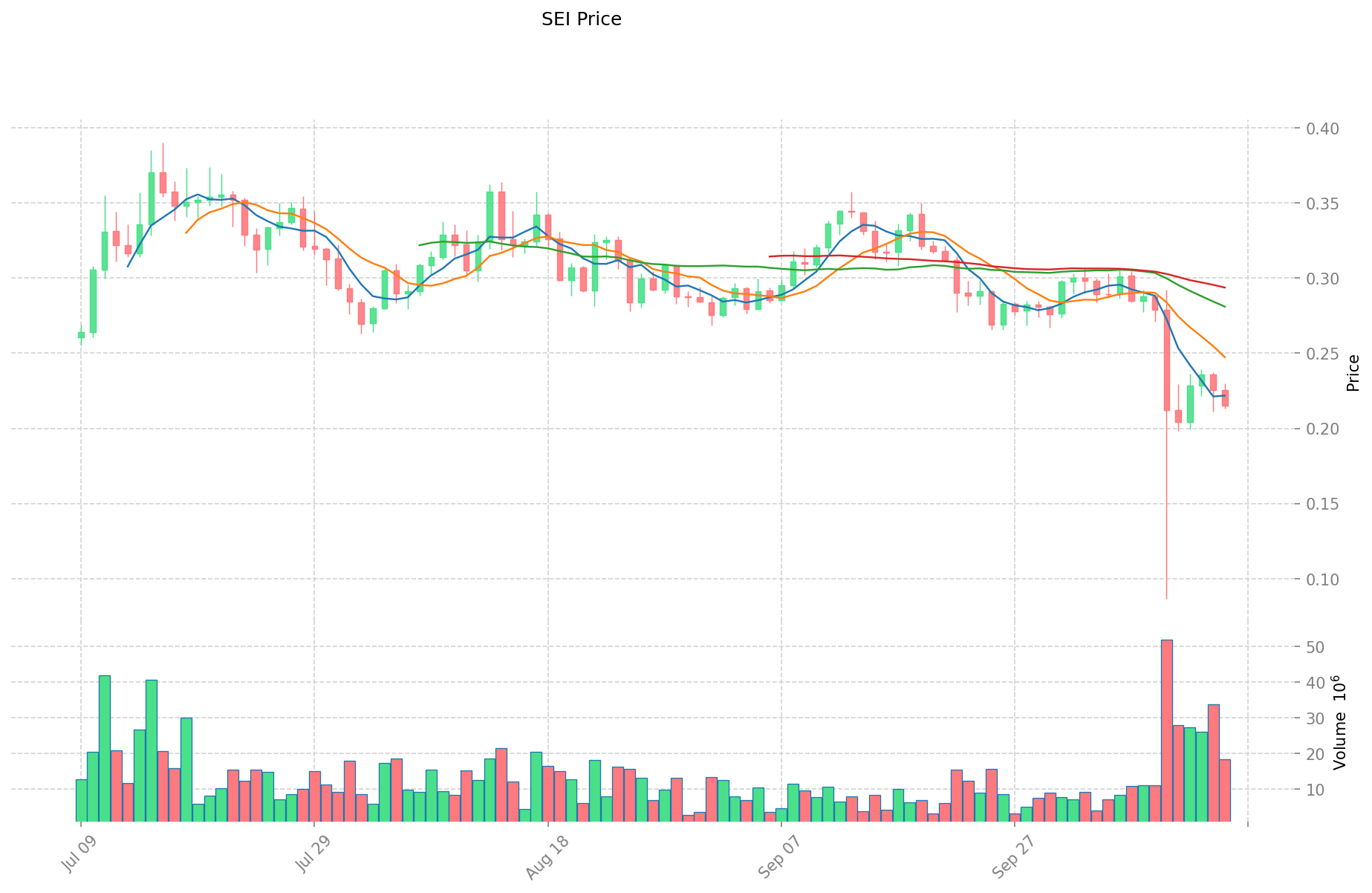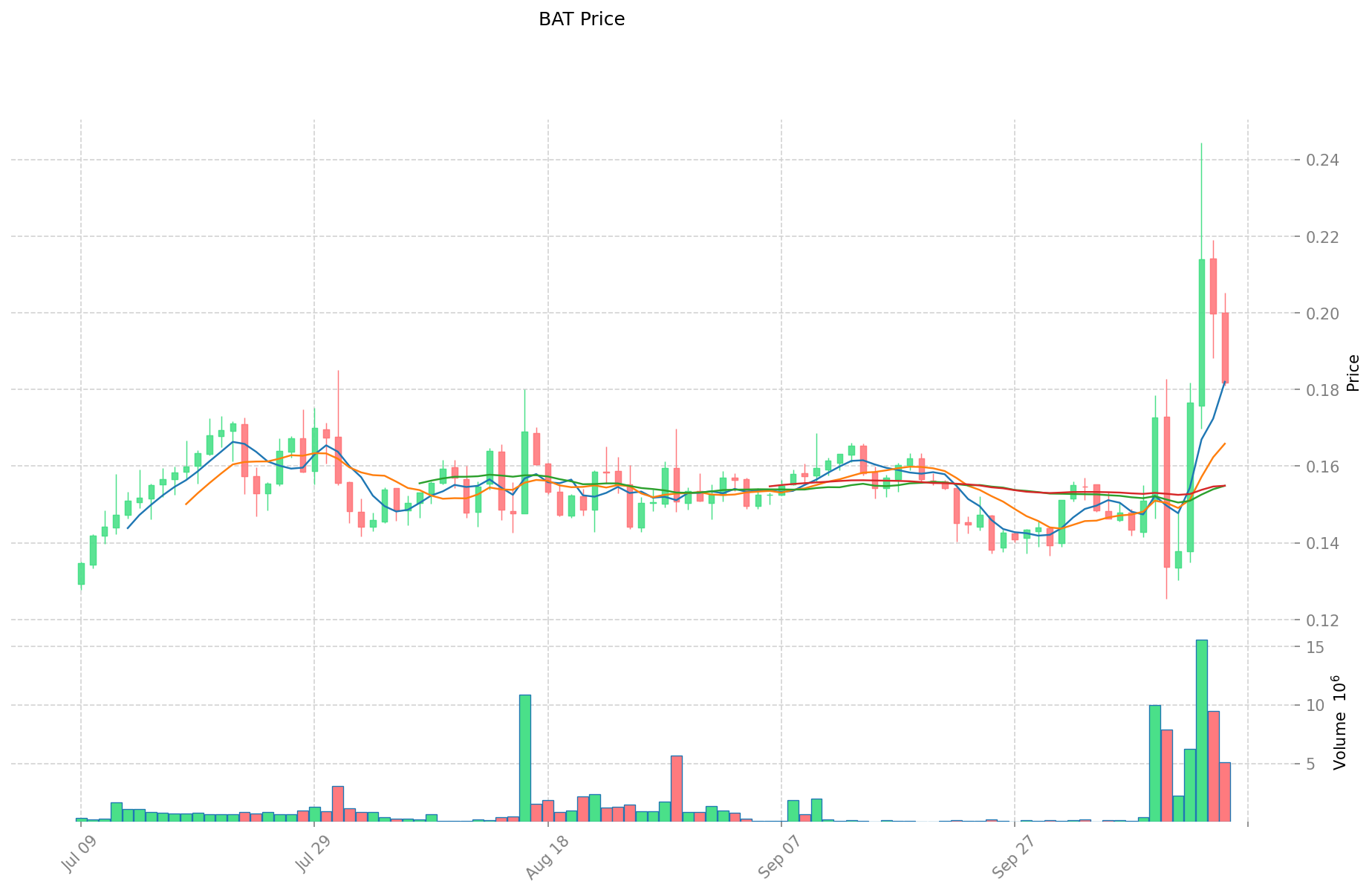SEI vs BAT: The Battle for Tech Supremacy in the Digital Age
Introduction: SEI vs BAT Investment Comparison
In the cryptocurrency market, SEI vs BAT comparison has always been a topic that investors cannot avoid. The two not only have significant differences in market cap ranking, application scenarios, and price performance, but also represent different cryptocurrency positioning.
SEI (SEI): Since its launch in 2023, it has gained market recognition for its focus on exchange services for digital assets.
BAT (BAT): Since its inception in 2017, it has been hailed as a solution for digital advertising, and is one of the cryptocurrencies with a unique use case in the browser ecosystem.
This article will comprehensively analyze the investment value comparison between SEI and BAT, focusing on historical price trends, supply mechanisms, institutional adoption, technical ecosystems, and future predictions, and attempt to answer the question that investors are most concerned about:
"Which is the better buy right now?"
I. Price History Comparison and Current Market Status
SEI and BAT Historical Price Trends
- 2024: SEI reached its all-time high of $1.14463 on March 16, 2024.
- 2021: BAT hit its all-time high of $1.9 on November 28, 2021.
- Comparative Analysis: In the recent market cycle, SEI has dropped from its all-time high of $1.14463 to its current price of $0.215, while BAT has fallen from its peak of $1.9 to $0.1803.
Current Market Situation (2025-10-16)
- SEI current price: $0.215
- BAT current price: $0.1803
- 24-hour trading volume: SEI $4,028,648 vs BAT $970,151
- Market Sentiment Index (Fear & Greed Index): 34 (Fear)
Click to view real-time prices:
- Check SEI current price Market Price
- Check BAT current price Market Price


II. Core Factors Affecting SEI vs BAT Investment Value
Supply Mechanisms Comparison (Tokenomics)
- SEI: Layer 1 blockchain with performance-focused architecture optimized for trading, DeFi and digital assets
- BAT: Basic Attention Token designed for digital advertising ecosystem
- 📌 Historical pattern: Digital asset scarcity and existing circulation volume provide clarity on value recognition for buyers
Institutional Adoption and Market Applications
- Institutional holdings: Market demand for both assets continues to evolve
- Enterprise adoption: SEI's trading optimization vs BAT's ecosystem integration show different value propositions
- Regulatory attitudes: Regulatory environment remains a significant factor affecting valuation for both tokens
Technological Development and Ecosystem Building
- SEI technological upgrades: Focus on speed, scalability and user experience for trading applications
- BAT technological development: Integration with advertising ecosystem and browser functionality
- Ecosystem comparison: SEI's performance in DeFi applications versus BAT's utility in content creator economy
Macroeconomic Factors and Market Cycles
- Performance during inflation: Market trends significantly impact valuation of both assets
- Monetary policy effects: Both tokens subject to broader cryptocurrency market conditions
- Geopolitical factors: Adoption rates and technological development paths influence long-term investment potential
III. 2025-2030 Price Prediction: SEI vs BAT
Short-term Prediction (2025)
- SEI: Conservative $0.17272 - $0.2159 | Optimistic $0.2159 - $0.317373
- BAT: Conservative $0.136875 - $0.1825 | Optimistic $0.1825 - $0.235425
Mid-term Prediction (2027)
- SEI may enter a growth phase, with an estimated price range of $0.2296806811 - $0.4247519445
- BAT may enter a steady growth phase, with an estimated price range of $0.2183658125 - $0.2873234375
- Key drivers: Institutional capital inflow, ETF, ecosystem development
Long-term Prediction (2030)
- SEI: Base scenario $0.463408304337875 - $0.514383217815041 | Optimistic scenario $0.514383217815041 - $0.55
- BAT: Base scenario $0.2810368006875 - $0.295088640721875 | Optimistic scenario $0.295088640721875 - $0.31
Disclaimer: This forecast is for informational purposes only and should not be considered as financial advice. Cryptocurrency markets are highly volatile and unpredictable. Always conduct your own research before making any investment decisions.
SEI:
| 年份 | 预测最高价 | 预测平均价格 | 预测最低价 | 涨跌幅 |
|---|---|---|---|---|
| 2025 | 0.317373 | 0.2159 | 0.17272 | 0 |
| 2026 | 0.36262564 | 0.2666365 | 0.14398371 | 24 |
| 2027 | 0.4247519445 | 0.31463107 | 0.2296806811 | 46 |
| 2028 | 0.480598959425 | 0.36969150725 | 0.3586007620325 | 71 |
| 2029 | 0.50167137533825 | 0.4251452333375 | 0.39963651933725 | 97 |
| 2030 | 0.514383217815041 | 0.463408304337875 | 0.291947231732861 | 115 |
BAT:
| 年份 | 预测最高价 | 预测平均价格 | 预测最低价 | 涨跌幅 |
|---|---|---|---|---|
| 2025 | 0.235425 | 0.1825 | 0.136875 | 0 |
| 2026 | 0.250755 | 0.2089625 | 0.127467125 | 14 |
| 2027 | 0.2873234375 | 0.22985875 | 0.2183658125 | 26 |
| 2028 | 0.27927838125 | 0.25859109375 | 0.1629123890625 | 42 |
| 2029 | 0.293138863875 | 0.2689347375 | 0.21514779 | 47 |
| 2030 | 0.295088640721875 | 0.2810368006875 | 0.2135879685225 | 54 |
IV. Investment Strategy Comparison: SEI vs BAT
Long-term vs Short-term Investment Strategy
- SEI: Suitable for investors focused on trading optimization and DeFi potential
- BAT: Suitable for investors interested in digital advertising ecosystem and browser integration
Risk Management and Asset Allocation
- Conservative investors: SEI: 30% vs BAT: 70%
- Aggressive investors: SEI: 60% vs BAT: 40%
- Hedging tools: Stablecoin allocation, options, cross-currency portfolios
V. Potential Risk Comparison
Market Risk
- SEI: Higher volatility due to newer market entry
- BAT: Mature market presence but subject to advertising industry fluctuations
Technical Risk
- SEI: Scalability, network stability
- BAT: Integration challenges, browser adoption rates
Regulatory Risk
- Global regulatory policies may have differing impacts on both assets
VI. Conclusion: Which Is the Better Buy?
📌 Investment Value Summary:
- SEI advantages: Performance-focused architecture, optimized for trading and DeFi
- BAT advantages: Established ecosystem, integration with digital advertising
✅ Investment Advice:
- New investors: Consider a balanced approach with a slight preference for BAT due to its established ecosystem
- Experienced investors: Explore SEI for its growth potential in the DeFi space
- Institutional investors: Evaluate both assets based on specific portfolio needs and risk tolerance
⚠️ Risk Warning: The cryptocurrency market is highly volatile. This article does not constitute investment advice. None
VII. FAQ
Q1: What are the main differences between SEI and BAT? A: SEI is a Layer 1 blockchain optimized for trading and DeFi, while BAT is a token designed for the digital advertising ecosystem. SEI focuses on performance and scalability for digital asset trading, whereas BAT integrates with browsers and content creators.
Q2: Which cryptocurrency has shown better price performance recently? A: As of October 16, 2025, SEI is trading at $0.215, while BAT is at $0.1803. SEI has a higher 24-hour trading volume of $4,028,648 compared to BAT's $970,151, indicating more recent market activity for SEI.
Q3: What are the long-term price predictions for SEI and BAT? A: By 2030, SEI is predicted to reach a base scenario of $0.463408304337875 - $0.514383217815041, with an optimistic scenario of up to $0.55. BAT's base scenario for 2030 is $0.2810368006875 - $0.295088640721875, with an optimistic scenario up to $0.31.
Q4: How do the supply mechanisms of SEI and BAT differ? A: SEI has a performance-focused architecture optimized for trading and DeFi, while BAT is designed specifically for the digital advertising ecosystem. The scarcity and circulation of both tokens play crucial roles in their value recognition.
Q5: What are the main risks associated with investing in SEI and BAT? A: SEI faces higher volatility due to its newer market entry and potential technical risks related to scalability and network stability. BAT is subject to advertising industry fluctuations and challenges in browser adoption rates. Both face regulatory risks that may vary globally.
Q6: How should investors allocate their portfolio between SEI and BAT? A: Conservative investors might consider allocating 30% to SEI and 70% to BAT, while aggressive investors could opt for 60% SEI and 40% BAT. The exact allocation should be based on individual risk tolerance and investment goals.
Share
Content